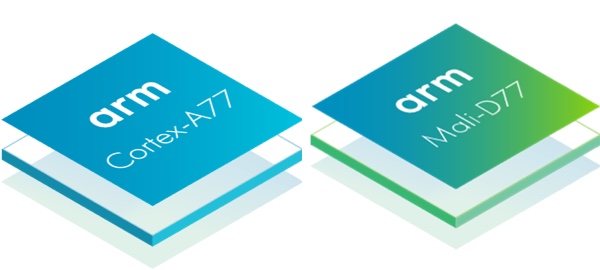How ARM’s New Mobile Chips Will Handle 5G, VR and Folding Phones
With ARM’s Cortex-A76 CPU and Mali-G77 GPU, the mobile processor designers want to define the tech that will appear on your smartphone in the next few years.
Smartphones continue to become more powerful, and phone makers are putting plenty of effort into experimenting with form factors and advanced features. But they need the right components to support these ambitions, and ARM’s newly revealed Cortex and Mali processors are ready to provide that for the next generation of phones.

ARM, based in Cambridge, England, doesn’t build chips, but instead designs their architecture. It then licenses these intellectual property cores (IP cores) to microchip manufacturers, who build it into the technology that smartphone makers and others put into their devices.
For example, last year’s CPU design, the Cortex-A76, is used by two of the major flagship processors in smartphones — Huawei, with its Kirin 980, and Qualcomm’s Snapdragon 855. The Kirin 980 also uses the same generation of Arm’s graphics processor, the Mali-G76 (which is why it’s such a blow to Huawei that Arm’s no longer doing business with the Chinese phone maker as a result of the U.S. government ban on providing Huawei with hardware and software).
The newest version of the Cortex-A series, the Cortex-A77, is designed with current cutting-edge trends in mind, in preparation for when they become the industry standard. This includes hardware tech like 5G connectivity as well as changes in form factor brought about by flexible devices. But the new chip designs also take into account changes in user behavior, such as the increase in HD gaming or AR and VR experiences on mobile devices or the use of smartphones as a mobile wallets.
Meet the Cortex-A77 and Mali-G77
All of this boils down to a need for increased performance and more efficient power consumption, which is exactly what the A77 chip will deliver.

Stefan Rosinger, ARM’s director of product management, described the A77 as "Basically pushing performance, keeping the same great efficiency versus the A76... which is going to give the user a nice experience for the [device] generations to come."
Sign up to get the BEST of Tom's Guide direct to your inbox.
Get instant access to breaking news, the hottest reviews, great deals and helpful tips.
Arm promises that the A77 will deliver 20% more performance over the A76, and that it achieves a 20% to 35% higher score in benchmark tests depending on the scenario. “With Arm, the ecosystem has a choice, we're not saying you have to take more performance, we're saying it's available if you like it, however if you want, you can actually save power” Rosinger said.
The Mali-G77 graphics processor brings a similar increase in power and efficiency to the video display side of things. While remaining the same size as its predecessor, the G76, the G77 has undergone a big redesign to keep up with the expected needs of smartphone users in the future. As a result, the G77 now has a 30% increase in power efficiency and a 30% increase in performance density over the G76, and it’s also a considerable 60% better at machine learning tasks, according to ARM.
One of the G77’s main benefits is that companies that use this IP are able to select how many of the 16 shader cores they want to use for a given device, down to a minimum of seven. This means that phone makers can go for all-out performance, or keep power consumption to a minimum.
With 5G and foldable devices, two of the hottest trends in smartphones right now, there’s going to be increased hardware demands from users who want to use them to their fullest potential. So whether it’s taking advantage of more reliable and faster internet connections, or using and switching between larger or multiple displays, ARM’s more powerful but still efficient designs will be able to support these requirements without making these new devices feel like they’re not as effective as older, simpler models.
Machine learning improvements
ARM also announced that it’s upgrading its Project Trillium machine learning platform. Announced last year, this neural processing unit is now ready for manufacturers to use inside their devices, where it can improve apps and services that already take advantage of algorithms, such as predictive keyboards, speech recognition and photo processing.
ARM’s announcements, made at the Computex trade show in Taiwan on Monday (May 27), come right after the company unveiled the Mali-D77, a display chip designed to be used in virtual reality headsets or on premium smartphones that can be docked into a headset like Samsung’s Gear VR. The processes the Mali-D77 does are nothing new — it corrects distortion and color aberrations caused by lenses in the headset and makes the experience smoother so it’s less likely to make you motion sick. But the D77 is dedicated to these tasks, which frees up the GPU to use less power and memory or focus on other instructions that further improve the user experience.
We’re focusing on the impact for smartphones, but ARM’s latest IPs don’t just go into handheld devices (though you can expect to see them powering some of 2020’s leading handsets). They also appear in smart TVs, set-top boxes, wearables, and are expected to appear in even more diverse areas like the automotive industry, infrastructure and IoT equipment once the new generation of processors are integrated into products over the next year.
Image Credits: ARM

Richard is based in London, covering news, reviews and how-tos for phones, tablets, gaming, and whatever else people need advice on. Following on from his MA in Magazine Journalism at the University of Sheffield, he's also written for WIRED U.K., The Register and Creative Bloq. When not at work, he's likely thinking about how to brew the perfect cup of specialty coffee.
